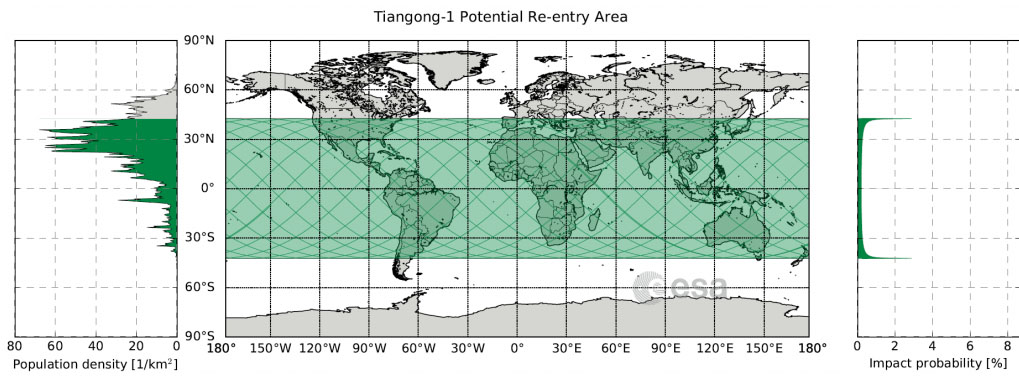Updated at 11:37 p.m.
An out-of-control Chinese space station, the Tiangong-1, is on a collision course with Earth, and could make impact as soon as Sunday evening.
But don’t worry, the chances of space junk landing on your head are slim.
According to the latest forecast by the Aerospace Corporation, which is tracking re-entry, the space station will re-enter Earth’s atmosphere at 10 p.m. ET Sunday evening, give or take seven hours in either direction, making Monday morning also a possibility.
The estimated re-entry time has been pushed back over the past several hours due to low solar activity, the European Space Agency said in its latest update.
Less certain is where debris from the 8.5 metric ton space station, most of which will burn up in the Earth’s atmosphere, could land. Trackers say the station could re-enter Earth’s atmosphere somewhere within a wide swath of the planet; within the latitudes 43ºN and 43ºS, according to ESA.

(Image credit: European Space Agency)
Though much of that area is covered by ocean, much of the U.S. is within the re-entry zone. In fact, only Alaska appears to be in the clear.
Predictions from trackers prompted Michigan Gov. Rick Snyder to activate his state’s Emergency Operations Center. The space debris may contain hydrazine, a highly toxic and corrosive substance. Anyone who comes in contact with it is asked to stay away and call 911.
While the debris from the space station could just as easily land in the ocean, or re-enter the atmosphere somewhere over South America, Africa, Asia, or even Australia, Gizmodo reports that if it does threaten a certain area in the U.S, the Federal Emergency Management Agency would be kept apprised of space debris data by the U.S. Strategic Command’s Joint Space Operations Center and likely spearhead a plan of action by warning federal, state, and local officials of any danger.
Readiness aside, the odds of somebody getting walloped by space debris are small.
“It is highly unlikely that debris from this reentry will strike any person or significantly damage any property,” said AeroSpace Corp. Even though predictions for re-entry have been in constant flux, AeroSpace Corp. added, “the likelihood of any one person (i.e. YOU) being struck by debris is still far less than winning the Powerball Jackpot.”
Only once has a small piece of man-made space debris struck a person — Lottie Williams of Tulsa, Okla., in the mid-1990s. She was hit in the shoulder by a piece of a returning Delta II rocket and lived to tell the tale.
For those looking to perhaps catch a glimpse of Tiangong-1 re-entering the atmosphere, AeroSpace Corp. said certain factors will dictate if that is possible, including location and time of day, and only until near re-entry will trackers have a good idea where debris will poke through the atmosphere.
“Depending on the time of day and cloud visibility, the reentry may appear as multiple bright streaks moving across the sky in the same direction,” AeroSpace Corp. wrote on its website. “Due to the relatively large size of the object, it is expected that there will be many pieces reentering together, some of which may survive reentry and land on the Earth’s surface.”
Tiangong-1 was the first space station built by and launched by China in 2011. Over the course of its life, there had been some manned missions to the station, but there is no one currently aboard. The country lost contact with it in 2016.
According to Space.com, China has a successor, the Tiangong-2 space lab, currently operating in Earth’s orbit.

